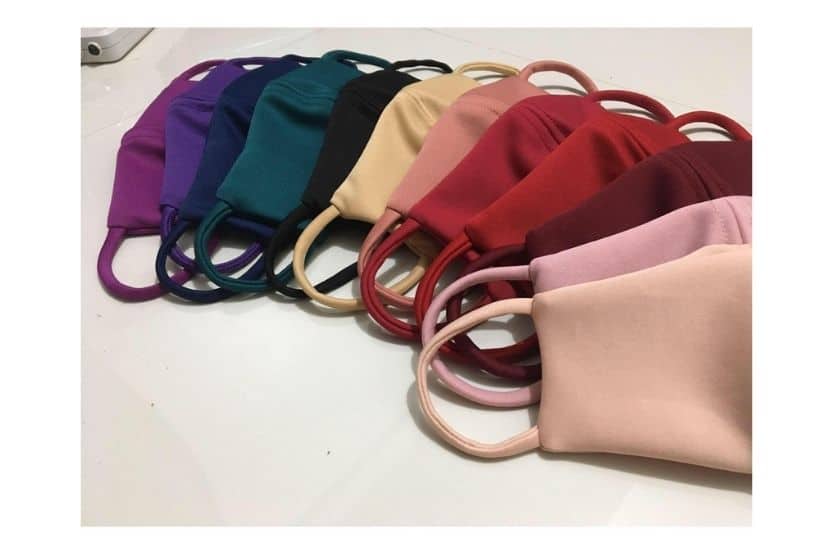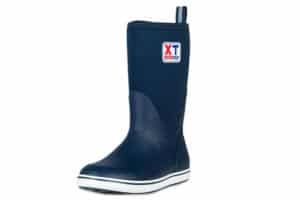Neoprene has many different uses. One of the most well-known applications is for making wetsuits. A wetsuit has to be waterproof, right? So, is Neoprene waterproof?
Neoprene is waterproof. Although it is rubber, it does not degrade as rapidly as natural rubber. Neoprene is also heat-resistant and can act as an insulator. It is used in wetsuits, scuba gear, fire doors, face masks, gaskets, and gloves. Manufacturers use Neoprene in various industries, such as medical, marine, construction, and many more.
However, Neoprene-coated products will deteriorate too when you constantly use them. Their lifespans depend on how you use them. If you are careful, they may retain their original A1 condition so that you could use them longer.
Read on to learn more about Neoprene’s characteristics, benefits, alternatives, pros, cons, and what you can expect in the future.
Is Neoprene Waterproof?

Neoprene is a waterproof rubber material that does not wear out as quickly as natural rubber. The material can also act as an insulator and is heat-resistant.
Companies worldwide use Neoprene in various fields, such as safety equipment, industrial, automotive, electrical, medical, marine, packaging, construction, and fashion companies. They manufacture your common scuba gear, wetsuits, face masks, weather stripping for fire doors, and gloves using Neoprene.
One example is the Precision Dip Coating LLC company based in Waterbury that uses Neoprene for its products, such as science-related instruments. In the fashion industry, it is used by Gareth Pugh, Rick Owens, and Vera Wang for their fabric as well.
Does Neoprene absorb water? Does Neoprene repel water? Neoprene does not absorb water; it repels water. The amount of air inside neoprene will determine how much water can penetrate it. The more air Neoprene contains, the less water can soak into the material. Also, the added nitrogen in Neoprene increases the insulation and increases the overall buoyancy because the cells of the fabric do not absorb water.
What Is Neoprene?
DuPont Company produced Neoprene as the first synthetic rubber in 1930. The technical name of Neoprene is polychloroprene. [1] It is a rubber product with many unique properties.
Manufacturers made it from the combination of oil and petroleum and dubbed it chlorine. Producers originally used Neoprene in television and other gadgets.
Neoprene has many good properties, such as being resistant to cold and hot temperatures and other environmental factors. Likewise, it can prevent water from penetrating its surface. [2]
General Neoprene Uses
Neoprene is used in different ways, primarily as a sealant, protective material against temperatures, fires, and other damaging factors. Specifically, neoprene has the following uses:
1. Sealants
Many industries use Neoprene as a sealant, coat, or adhesive. Neoprene can effectively seal off air or water leakages. However, these sealants may become worn out, so you have to replace them after a certain amount of time.
2. Insulators
They are used as the insulating material in light bulbs, wires, and electric transformers. Neoprene also acts as a protective cover for electronic gadgets and devices. Your cell phone may be a recipient of Neoprene technology.
3. Protective Gear
Neoprene serves as protective gear for safety purposes. Also, for keeping parts of your vehicles from getting damaged. Neoprene is used in the construction industry due to its all-weather resistance characteristics.
Furthermore, Neoprene is resistant to temperatures and pressure, which is ideal for protective covers. Additionally, its ability to resist other damaging factors makes it the primary material for vehicles.
4. Paddings
You can use Neoprene as a cushion, padding, or absorbent in the automotive and medical fields. Companies use it where padding is required, such as masks, lab gear, gloves, car seats, or interior covers.
Specific Neoprene Uses
1. Masks
Neoprene is used in Halloween masks, Christmas party masks, masquerade party masks, and water events. You will not get your face wet with water from the water guns or similar gadgets.
2. Sports Equipment
Sports companies use scuba diving gear, socks, and waders for kids when they embark on-water activities.
Some sporting shoes contain Neoprene too to ascertain better insulation and protection from inclement weather.
3. Office and Home Gadgets/Equipment
Neoprene is used in laptop sleeves, mousepads, remote controls, lunch bags, coolers, and tablet holders. Neoprene will prevent liquid from getting inside these gadgets.
4. Vehicles
It protects the covers of your vehicles and keeps them free from stains, water, and other liquid matter. If you have kids that often ride the car with you, you need Neoprene-covered seats/interior.
5. Hospitals/Labs
Many medical practitioners recommend Neoprene material for braces, bandages, casts, gloves, dental devices, and laboratory equipment. Laboratories use it for autoclavable materials.
Again, is Neoprene waterproof? Neoprene is a waterproof material that does not wear out as rapidly as natural rubber. It can also act as an insulator as it is heat and cold-resistant. Manufacturers use Neoprene in wetsuits, face masks, scuba gear, gloves, and weather stripping for fire doors.
This is also the reason why manufacturers use Neoprene in the fashion world. Likewise, in industrial products, safety equipment, medical, automotive, electrical, marine, packaging, electronics, and construction materials.
Neoprene Pros and Cons
Pros
1. Durable
Neoprene is produced using another method compared to the commonly used method, which is weaving. Companies produce Neoprene through a limestone process or the oil-derived process. Neoprene is more durable due to this production difference.
2. Flexible
You can easily stretch Neoprene to fit scuba divers or swimmers. The material can expand or shrink depending on the user’s body shape. If it does not have that property, divers and swimmers will have difficulty using it.
3. Insulating Property
It can retain heat to keep divers comfortable and warm while keeping away coldness from seeping in. Neoprene-insulated diver’s suit is most useful for deep-sea divers who go into the seas’ deepest abyss.
Neoprene-made materials can keep your body heat inside and prevents cold temperatures from getting in. Therefore, it is also a good material for gloves and boots.
4. Waterproof
Neoprene can keep off liquid getting into diving gear and electronic devices to protect them from getting damaged. This property is due to Neoprene’s water or liquid immiscibility.
Seat covers with Neoprene material are also popular, especially with families who have kids. You can allow your kids to have fun while ensuring that your car or sofa seats remain dry.
Does Neoprene absorb water? Does Neoprene repel water? Neoprene repels water. It does not absorb water. This means it is waterproof. It is resistant to oil and heat as well. Neoprene clothing and wetsuits are stitched and glued in a way that gives them extra resistance to water.
5. Slow Rate of Oxidation
Neoprene has a slow rate of oxidation, making it perfect to use outdoors for long periods. So, it is also effective when used in personal paraphernalia and traveling items.
6. Less Prone to Corrosion
Neoprene does not corrode easily like other rubber materials. You can choose it safely over other rubber types. But take note that it can also corrode over time due to wear and tear.
7. Washable
You can wash Neoprene-containing materials with mild detergent and water. Do not apply the detergent directly to the item. Wash the item first with water, then prepare a mild detergent-water solution. Dissolve the detergent in an ample amount of water and use this to wash off your item gently.

If you are washing the cover of your phone or similar gadgets, ensure that you do not introduce water to your phone or gadget. The cover may be waterproof, but most phones and gadgets are not.
Air dry your item and do not put it under direct sunlight. Sunlight can destroy its Neoprene content.
Cons
Pricey
Neoprene is more expensive compared to other waterproof products. However, you will get your money’s worth as its lifespan is longer than other rubber products.
Reduced Efficiency through Time
Water can seep into the material as it gets older. The only difference is that it takes longer for Neoprene-made materials to get worn out than ordinary materials.
Neoprene Properties That Makes It Waterproof
1. Oil and Petroleum Components
Neoprene is made of oil and petroleum. Water cannot get through the Neoprene material as oil and petroleum do not mix well with water. This property makes Neoprene water-resistant.
2. Fabric Strength
Neoprene is made of strong materials that can withstand pressure, such as water pressure. Neoprene can withstand other environmental pressures, too, such as wind pressure. This fact makes it an ideal material for gadgets or devices used under strong water pressure.
3. Ultra-Tightness
Neoprene’s texture is ultra-tight that water cannot penetrate through it. This property also prevents cold or hot temperatures from entering the material.
Other Advantages of Using Neoprene
Is having neoprene waterproof devices and equipment at home worthwhile? If you are a sports-minded person, who treasures your gadgets and the family’s safety as well, then you will find that using neoprene is most helpful.
1. Keeps You and Your Family Dry While Having Fun
Staying dry even when at sea and having your devices protected from getting wet or corroded would give you fewer worries. Gadgets with neoprene have a longer existence than those without.
You will not be worrying about your kids accidentally dropping their smartphones or spilling drinks on your laptop while you are working. Most non-Neoprene gadgets get damaged easily once exposed to moisture or seawater breeze.
Also, your swimming or diving gear would protect you from moist, water, and extreme temperatures.
2. Fewer Gadget Expenses
Devices with neoprene get longer lifespans because of the protection the material provides. This property will significantly reduce the frequency of buying replacements for your gadgets. Lesser replacements provide lesser expenditures on gadgets.
3. Protects You and Your Family from Getting Sick
Since Neoprene swimwear is waterproof, it ensures that you are dry while enjoying your activity. You can do your water activity for as long as you want in any weather – without the fear of getting sick.

Alternatives to Neoprene
Neoprene is not the only material that you can use as a water-resistant substance. There are other options. However, most of these materials lack some qualities. Neoprene has better properties than most similar rubber materials.
Other products, such as Neo green, Aquatherm, Ariaprene, Naturalprene, can act as substitutes for Neoprene. But Neoprene is still your best option.
Another option is Lycra, which is also a waterproof rubber material. But it is not effective as an insulator.
Silicone is more effective in resisting moisture and water; therefore, you can use it instead of neoprene. However, it is limited to protecting gadgets, such as laptops, mobile phones, and phone holders.
Silicone may not function well when used for other purposes as it lacks insulation properties that may be good for other purposes.
The thermocline is another substitute for Neoprene. It can provide amazing insulating characteristics, but it is not as light as Neoprene. Furthermore, when you take it deeper into the water, it gets less effective.
Future of Neoprene Waterproofing
Companies will continue to use Neoprene as a waterproof material for decades to come. As one company claimed, it will stay active as a manufacturer of Neoprene rubber despite numerous competitors in the field.
The demand for Neoprene has increased in the electronic and electrical fields, while it’s less in demand in the construction and automotive sector.
Note that the DuPont Company produced Neoprene in the 1930s and has been going strong today. This fact indicates its continued growth for the next years and may drastically increase as players from the automotive and construction come into play.
Mordor Intelligence foretasted that Neoprene shall have a compounded annual growth rate of 3.50% between 2021-2026. On the other hand, Infinium Global Research said that the global market for Neoprene is expected to grow by 4.1% from 2019-2025. [3]
Conclusion – Is Neoprene Waterproof?
Neoprene is waterproof. Neoprene is also heat and cold-resistant, so that you can use it in scuba gear, wetsuits, face masks, gloves, and fire doors. Due to these properties, manufacturers in various fields use Neoprene for their products.
Nonetheless, Neoprene is not invincible. Like any other product, Neoprene material deteriorates over time. Hence, expect that your gadgets, equipment, or wet suits will not be as effective after several years of use. Companies still consider Neoprene a good material in manufacturing products due to its waterproof and insulating properties.
Related reading:



